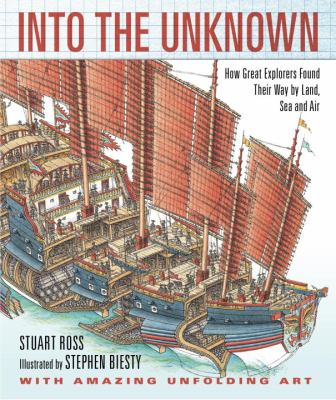
by Stuart Ross
Book list This handsome book presents 14 journeys of exploration, from Pytheas the Greek in 240 BC to the Apollo moon landing in 1969. Sailors dominate the first half of the book: Leif Eriksson, Marco Polo, Zheng He, Christopher Columbus, Ferdinand Magellan, and Captain Cook. The second half follows explorers David Livingstone and Mary Kingsley through Africa, Umberto Nobile to the Arctic, Auguste Piccard up into the stratosphere, Jacques Piccard down into the ocean's depths, and Edmund Hillary and Tenzing Norgay to the summit of Mount Everest. A glossary and a source bibliography are appended. Clearly written chapters trace the expeditions and underscore the challenges that the explorers faced. Precise, beautifully shaded colored-pencil artwor. appears throughout the book and, notably, on a large, foldout sheet tipped into a page of each chapter. From the maps to the drawings of vessels and artifacts to the detailed cutaway views that make each bit of technology more understandable, Biesty's well-labeled illustrations make this one of the most visually fascinating books available on explorers.--Phelan, Caroly. Copyright 2010 Booklist From Booklist, Copyright © American Library Association. Used with permission. School Library Journal Gr 4-8-The major accomplishments of 14 explorers are presented with strong support from illustrations. Chapters move chronologically from Pytheas in 340 BC to the 1969 Moon landing, combining famous names such as Marco Polo and Magellan with lesser-known but equally interesting figures including Mary Kingsley (Africa), Umberto Nobile (North Pole), and Auguste Piccard (stratospheric flight and deep-sea submersion). Each chapter provides basic background on the topic, then focuses largely on the nuts and bolts of the journeys, including travel conditions, navigation techniques, and vehicle construction. Lively writing captures the excitement of exploration while providing just enough geographic and historical detail. Biesty's pencil and colored pencil artwork ably builds upon the text, with each chapter featuring several insets plus one dramatic gatefold per chapter. In each fairly sturdy foldout, an initial illustration expands in two consecutive unfoldings to reveal further details. For Piccard's undersea exploration, for example, a map identifies the location of the Mariana Trench. This unfolds to show the depth levels of the descent, with helpful visual comparisons to a stack of Empire State Buildings (for depth) and Airbuses (for air pressure). The sequence climaxes with a final foldout depicting Piccard's deep-sea craft in detail, with labeled cross-sections in Biesty's appealing style. Other appropriate touches round out the well-conceived package, including pages with textured paper effects to match the era, from early parchment to a Moon map for the Apollo 11 voyage. Useful for report writers, attractive to browsers, and just right for readers who are curious about the adventure of exploration.-Steven Engelfried, Wilsonville Public Library, OR (c) Copyright 2011. Library Journals LLC, a wholly owned subsidiary of Media Source, Inc. No redistribution permitted. (c) Copyright 2010. Library Journals LLC, a wholly owned subsidiary of Media Source, Inc. No redistribution permitted. School Library Journal Gr 4-8-From Pytheas the Greek to Neil Armstrong and Buzz Aldren, Ross recounts the stories of daring expeditions undertaken by men and women through the ages. An accessible text and superb visuals-foldout diagrams and spectacular physical maps and cross-sections-guarantee hours of enjoyment. (May) (c) Copyright 2011. Library Journals LLC, a wholly owned subsidiary of Media Source, Inc. No redistribution permitted. (c) Copyright 2010. Library Journals LLC, a wholly owned subsidiary of Media Source, Inc. No redistribution permitted. |